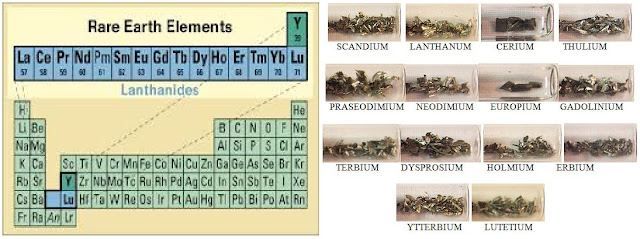Rare Earth Elements and the Environment
Appropriate and efficient use of a range of greener products is one important aspect of more sustainable city living. Consider: switching on a compact fluorescent bulb; using certain types of rechargeable, lower toxicity batteries; driving a hybrid car; using electricity generated from wind turbines; using a torch with LEDs.
All these greener products, along with many non-green ones 'from iphones to missiles' as a recent Telegraph article puts it, currently need rare earth elements in their production (see below). The supply of these elements raises many environmental issues.
- [if !supportLists][endif]The inner surfaces of compact fluorescent light bulbs are coated with varying blends of metallic and rare-earth (europium, terbium, yttrium) phosphor salts, which luminesce.
- [if !supportLists][endif]Hybrid cars use nickel-metal hydride batteries, the anode of which contains lanthanum (in the form of mischmetal, a mix of metals, in this case 50% lanthanum).
- [if !supportLists][endif]Neodymium-iron-boron high strength permanent magnets are used in hybrid car motors and wind power generators. Relatively small amounts of the rare earth metal dysprosium can be used with neodymium to raise the strength and corrosion resistance of such permanent, high strength magnets.
- [if !supportLists][endif]Cerium shows much promise in fuel cells (solid oxide types) where the oxide is used as an electrolyte due to its good oxygen ion conductivity.
- [if !supportLists][endif]Energy saving LEDs use cerium, yttrium and europium.
The supply of rare earth elements is an issue in terms of the environment for several reasons. Global demand for rare earth's is rising and supplies are limited. This poses a threat to a big expansion in low carbon technologies simply on grounds of availability, independent of price.
Limited supplies and high global demand for rare earth's points to rising prices. High and rising prices could make a range of low carbon industries, in countries without good supplies of their own, less competitive. As a result, development of such industries could be restricted.
Planned expansion in the use of wind power would need larger amounts of neodymium and dysprosium (about 4% of the present global supply according to a publication of the European Commission's Joint Research Centre). Production of permanent magnets for generators could be hampered unless the supply of these is raised. There is uncertainty about this due to concentration of supplies in China.
Rare earth's are not easily recycled. Continued high demand, rising prices and concentration of supply could result in more countries seeking to develop new sources and/or open new or currently dormant mines, bringing many consequent environmental impacts. Alternatively production might rise considerably in China, where mining is likely to be even higher in impact.
Rare earth's are not easily substituted. This, along with lack of secure, affordable, accessible supplies, could result in countries turning away from clean technologies like solar and wind and developing alternatives that are less clean or have other impacts, such as increasing land demand in the case of biomass/biofuel.



